I am currently faced with the embroidery equivalent of a solution in search of a problem. I have a beautiful set of Heathway crewel wool and I need a problem, I mean a project, on which to use it.
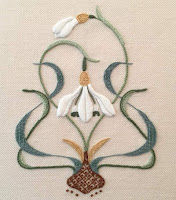 |
| Melbury Hill's Galanthus Collector (original) |
As a bonus, you can purchase a full kit or just the stamped linen. Since I wanted to use my Heathway wools, being able to buy the stamped linen was the perfect option! Another plus is that postage to the States is very reasonable.
To the right is the original design of The Galanthus Collector, a snowdrop, stitched in Appleton crewel wool. You can view it in greater detail on Melbury Hill's site. The ground fabric is linen twill which is traditional for crewel and a lovely fabric on which to embroider. I like how the design is asymmetrical, but balanced. That's one of my favourite things!
So, I have a design and now I need to figure out stitches and colours.
Heathway wool is organised by colour family. Each family is divided into nine shades which makes shaded embroidery really easy. The lightest colour is 1, the darkest is 9. Each card in the photo below is an individual colour family.
I read something many years ago that recommended using every other colour for basic shaded work if you have a fairly fine gradation between the colours. The change from shade to shade in Heathway's colour families is very gradual. Since I'm playing with these threads, I want to see how the shades work together. I'm going to use all odds for one set of elements and then switch to evens for another.
In addition, I hope to experiment a bit with texture, but I don't want to go too crazy. I would prefer to have something nice to look at when I'm finished!
Because I don't know what I'm doing, I'm not necessarily going to be able to stitch in the proper order (i.e., back to front elements). Fortunately, this is a fairly simple design so that won't be much of a problem.
I started with the upper flower bud so I could see how the white looked. Also, after looking at snowdrop photos, I decided to add some light grey ribbing on the petals. (By the way, I'm not following the stitch plan of the original design.)
I'm using a Bohin #24 chenille needle rather than a crewel needle. I prefer chenilles for crewel. I like the large eye and the fact that the commercial kits I used to stitch came with chenille needles, so I'm used to them.
Here's the completed upper bud. Unfortunately, there's not enough contrast between the Heathway white and the colour of the linen twill. It's not bright enough, so I'm going to have to find a different white. I'm happy with the grey lines, but I don't care for the green (apple family) and will switch to a different green when I change out the white.
Next, on to the lower leaves. With the odd numbered shades, I embroidered adjacent rows of chain stitch using three shades of leaf green (5,7,9) beginning with the darkest (9) and moving on to the lighter shades. I also snuck in a little bit of shading on the central flower stems. The stems are naturally broken into three sections and I chain stitched them starting at the bottom with 9, then 7, and finally 5. They become lighter as you go towards the top of the design. I really like the effect. It's fairly subtle and is probably one of those things that won't be noticed unless you look closely.
I've made a good start and am happy with the look of the chain stitched leaves. Heathway is a lovely, soft wool. It's not hairy and I'm not having issues with it fraying unless I have a thread that's too long. (Sometimes I forget to cut the threads in half in order to have a reasonable thread length.)
I need to go rummaging in my stash for a whiter white.
References
Here's the completed upper bud. Unfortunately, there's not enough contrast between the Heathway white and the colour of the linen twill. It's not bright enough, so I'm going to have to find a different white. I'm happy with the grey lines, but I don't care for the green (apple family) and will switch to a different green when I change out the white.
Next, on to the lower leaves. With the odd numbered shades, I embroidered adjacent rows of chain stitch using three shades of leaf green (5,7,9) beginning with the darkest (9) and moving on to the lighter shades. I also snuck in a little bit of shading on the central flower stems. The stems are naturally broken into three sections and I chain stitched them starting at the bottom with 9, then 7, and finally 5. They become lighter as you go towards the top of the design. I really like the effect. It's fairly subtle and is probably one of those things that won't be noticed unless you look closely.
I've made a good start and am happy with the look of the chain stitched leaves. Heathway is a lovely, soft wool. It's not hairy and I'm not having issues with it fraying unless I have a thread that's too long. (Sometimes I forget to cut the threads in half in order to have a reasonable thread length.)
I need to go rummaging in my stash for a whiter white.
References
- Melbury Hill
- Heathway Crewel Wool (from Jessica Grimm)
I buy Heathway from Jessica. She sells the wool at a reasonable price with affordable postage and ships quickly! Heathway is available from other sources, but I prefer Jessica. Also, as of this writing Heathway has just been sold to a new owner and they are in the process of setting up a new web site.

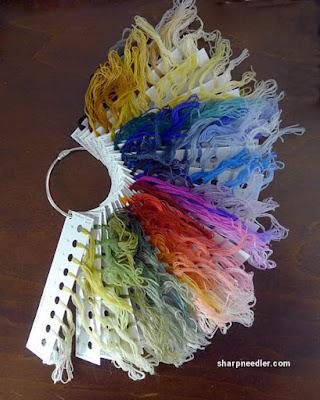

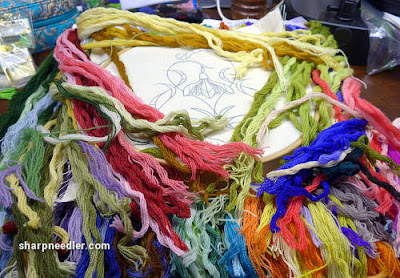


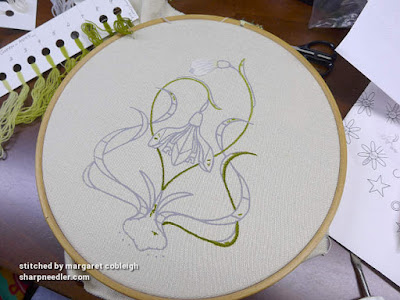
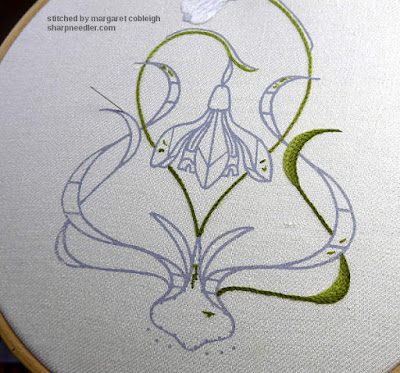
Thank you for the shout-out! And happy stitching.
ReplyDeleteI embroidered a lilies and roses cushion, pattern by Stafford Whiteaker. I changed the cream or charcoal recommended background for a dull navy, but kept the grays and lilacs (Appleton wool colours). I was very surprised at how well it worked, when you look at it the dull grays appear to be shades of lilac, and yet they definitely are not!
ReplyDelete